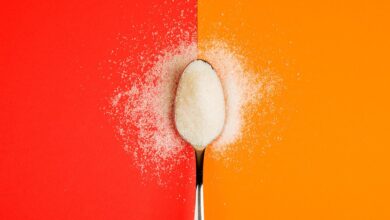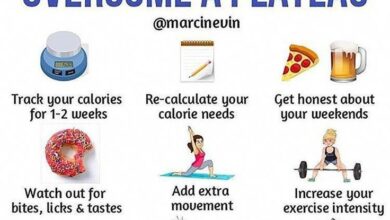10 Tips to Overcome a Weight Loss Plateau
10 tips to overcome a weight loss plateau – Hitting a weight loss plateau can be incredibly frustrating. You’re putting in the work, eating right, and exercising consistently, but the scale just refuses to budge. It’s like you’ve hit a wall, and the motivation to keep going can dwindle.
But don’t despair! There are several things you can do to overcome this plateau and get back on track towards your goals.
This guide will explore 10 actionable tips to help you break through your weight loss plateau. From reevaluating your calorie intake to addressing hormonal factors, we’ll delve into strategies that can jumpstart your progress and get you back on the path to success.
So, let’s dive in and explore these tips that could be the key to unlocking your weight loss journey!
Reassess Your Calorie Intake
Hitting a weight loss plateau can be frustrating, but it’s a common experience. One of the most important things to do when you’re stuck is to take a hard look at your calorie intake. You might be consuming more calories than you think, even if you’re following a strict diet plan.Accurate calorie tracking is crucial for weight loss.
When you track your calories, you become more aware of what you’re eating and how much you’re consuming. This awareness can help you make better food choices and identify areas where you can cut back.
Identifying Potential Calorie Underestimation
It’s easy to underestimate your calorie intake. Here are some common reasons why:
- Portion sizes:We often overestimate the size of our portions, especially when eating out. Using measuring cups and spoons can help you get a more accurate idea of how much you’re consuming.
- Hidden calories:Many foods contain hidden calories, such as sauces, dressings, and condiments. Be sure to check the nutrition labels of all your food items.
- Underestimating activity levels:Your daily activities, like walking, cleaning, or playing with your kids, burn calories. You may be underestimating how many calories you burn through these activities.
- Not tracking everything:You might forget to log snacks, drinks, or even a few bites of food here and there. Be sure to track everything you consume, even the smallest amounts.
Adjusting Calorie Intake
Once you’ve identified potential calorie underestimation, you can adjust your intake to promote further weight loss. Here are some tips:
- Start by reducing your calorie intake by 200-500 calories per day.This can be done by cutting back on high-calorie foods, increasing your intake of fruits and vegetables, and choosing lean protein sources.
- Consider your activity level.If you’re more active, you may need to consume more calories to maintain your weight. If you’re less active, you may need to consume fewer calories.
- Don’t make drastic changes.It’s important to make gradual changes to your diet to avoid feeling deprived or discouraged. Aim to reduce your calorie intake by a small amount each day.
- Focus on quality over quantity.Instead of just focusing on the number of calories you’re consuming, focus on the quality of the food you’re eating. Choose nutrient-rich foods that will keep you feeling full and satisfied.
Review Your Exercise Routine
If you’ve been sticking to the same exercise routine for a while, it’s time to shake things up. Your body might have adapted to your current workouts, making them less effective for weight loss.
Varying Exercise Intensity and Duration
Our bodies are incredibly adaptable. When we perform the same exercises repeatedly, our bodies become efficient at those specific movements, leading to a plateau in our progress. To overcome this, we need to challenge our bodies in new ways.
- Increase the intensity:If you’re used to jogging at a moderate pace, try incorporating intervals of faster running or hill sprints.
- Increase the duration:If you typically workout for 30 minutes, try extending your sessions to 40 or 45 minutes.
- Increase the resistance:If you’re lifting weights, gradually increase the weight you lift or the number of repetitions you perform.
Incorporating New Exercises or Activities
Trying new exercises can help you target different muscle groups, improve your overall fitness, and keep your workouts engaging.
- Try a new group fitness class:Zumba, spin, or kickboxing can offer a fun and challenging way to get your heart rate up.
- Take up a new sport:Tennis, swimming, or rock climbing can be excellent ways to build muscle and burn calories.
- Incorporate strength training:Strength training can help you build muscle mass, which can boost your metabolism and aid in weight loss.
Finding Enjoyable and Sustainable Forms of Exercise
Exercise should be enjoyable and sustainable in the long run. If you dread your workouts, you’re less likely to stick with them.
- Find activities you enjoy:If you love dancing, try taking a dance class. If you enjoy being outdoors, go for hikes or bike rides.
- Make it social:Work out with a friend or join a fitness group.
- Listen to your body:Don’t push yourself too hard, especially when starting a new exercise routine.
Monitor Macronutrient Ratios
You’ve adjusted your calorie intake and exercise routine, but the scale hasn’t budged. It’s time to look at the composition of your diet: macronutrients. While calories are essential for weight loss, the breakdown of those calories into protein, carbohydrates, and fats plays a crucial role in achieving your goals.
Macronutrients and Weight Loss, 10 tips to overcome a weight loss plateau
Each macronutrient contributes differently to weight loss. Protein is essential for building and repairing tissues, while carbohydrates provide energy. Fats are crucial for hormone production and nutrient absorption. However, excess consumption of any macronutrient can lead to weight gain.
Adjusting your macronutrient ratios can help you feel fuller for longer, optimize your metabolism, and potentially enhance fat loss.
Tips for Tracking and Adjusting Macronutrient Intake
Here are some tips to track and adjust your macronutrient intake:
- Use a food tracking app or online tool. These tools can help you log your meals and calculate your macronutrient intake. Popular options include MyFitnessPal, LoseIt!, and Cronometer.
- Experiment with different macronutrient ratios. There is no one-size-fits-all approach. Some individuals may benefit from a higher protein intake, while others may find success with a moderate-carb diet. Start by adjusting one macronutrient at a time and monitor your progress.
- Consult a registered dietitian. A dietitian can help you determine the optimal macronutrient ratio for your individual needs and goals.
Address Sleep and Stress
When you’re trying to lose weight, it’s easy to focus solely on diet and exercise. However, neglecting sleep and stress management can significantly hinder your progress. These factors play a crucial role in regulating hormones that control hunger, metabolism, and fat storage.
Impact of Sleep and Stress on Weight Loss
Sleep deprivation and chronic stress can disrupt your body’s hormonal balance, leading to increased appetite, cravings for unhealthy foods, and difficulty burning calories. This is because insufficient sleep and elevated stress levels can increase the production of cortisol, a hormone that promotes fat storage, particularly in the abdominal area.
Hitting a weight loss plateau can be discouraging, but it’s a common part of the journey. Remember, your body is smart and adapts to changes. Sometimes, the best way to overcome a plateau is to shake things up by rediscovering lost healthy habits, like incorporating new exercises or finding creative ways to make your meals more exciting.
Check out this article on ways to rediscover lost healthy habits for some inspiration. By re-evaluating your routine and finding new ways to challenge yourself, you can break through the plateau and continue your weight loss journey.
“Insufficient sleep and elevated stress levels can increase the production of cortisol, a hormone that promotes fat storage, particularly in the abdominal area.”
Furthermore, lack of sleep can negatively impact your energy levels and motivation, making it harder to stick to your exercise routine and healthy eating plan.
Hitting a weight loss plateau can be frustrating, but don’t give up! One of my favorite tips is to keep things interesting with new flavors and textures. That’s where Trader Joe’s comes in, especially during the fall. I’ve been loving their seasonal pumpkin-flavored snacks, and you can find some really delicious and RD-approved options here.
These tasty treats can help keep your cravings in check and make your weight loss journey more enjoyable.
Strategies for Improving Sleep Quality and Managing Stress
Prioritizing sleep and stress management is essential for achieving your weight loss goals. Here are some effective strategies:
Improving Sleep Quality
- Establish a Regular Sleep Schedule:Go to bed and wake up at the same time each day, even on weekends, to regulate your body’s natural sleep-wake cycle.
- Create a Relaxing Bedtime Routine:Wind down an hour or two before bed by engaging in calming activities such as taking a warm bath, reading a book, or listening to soothing music.
- Optimize Your Sleep Environment:Ensure your bedroom is dark, quiet, and cool, and invest in a comfortable mattress and pillows.
- Limit Caffeine and Alcohol Before Bed:These substances can interfere with sleep quality.
- Get Regular Exercise:Physical activity can promote better sleep, but avoid exercising too close to bedtime.
Managing Stress
- Practice Stress-Reducing Techniques:Incorporate mindfulness meditation, deep breathing exercises, or yoga into your daily routine to calm your mind and body.
- Engage in Activities You Enjoy:Spending time on hobbies or activities that bring you joy can help alleviate stress.
- Connect with Loved Ones:Social support can be a powerful stress reliever.
- Seek Professional Help:If stress is overwhelming, consider seeking guidance from a therapist or counselor.
Creating a Supportive and Relaxing Environment
Your home environment plays a significant role in promoting relaxation and sleep. Here are some tips for creating a supportive and relaxing space:
- Minimize Distractions:Turn off electronic devices, such as TVs, phones, and computers, at least an hour before bedtime. The blue light emitted from these devices can interfere with melatonin production, a hormone that regulates sleep.
- Create a Soothing Atmosphere:Use soft lighting, calming colors, and pleasant scents to create a relaxing ambiance.
- Invest in Comfortable Bedding:Choose a comfortable mattress, pillows, and bedding that promotes restful sleep.
Consider Hormonal Factors
Your body’s hormones play a crucial role in regulating metabolism, appetite, and fat storage. Imbalances in these hormones can contribute to weight loss plateaus, making it challenging to shed those extra pounds.
Common Hormonal Imbalances and Their Impact on Weight Management
Hormonal imbalances can significantly impact weight management. Some common hormonal imbalances and their effects on weight loss include:
- Hypothyroidism:This condition involves an underactive thyroid gland, leading to a slower metabolism, fatigue, and weight gain.
- Insulin Resistance:This condition prevents your body from using insulin effectively, leading to increased blood sugar levels and fat storage.
- Cortisol Imbalance:Elevated cortisol levels, often associated with stress, can lead to increased appetite, fat storage, and difficulty losing weight.
- Leptin Resistance:Leptin, a hormone that signals fullness, can become resistant, making it difficult to feel satiated, leading to overeating and weight gain.
- Ghrelin Imbalance:Ghrelin, a hormone that stimulates appetite, can be elevated, leading to increased hunger and difficulty controlling food intake.
Addressing Hormonal Imbalances
Addressing hormonal imbalances is crucial for overcoming weight loss plateaus.
- Lifestyle Changes:
- Stress Management:Engage in stress-reducing activities like yoga, meditation, or spending time in nature.
- Sleep Prioritization:Aim for 7-9 hours of quality sleep each night to regulate hormone production.
- Regular Exercise:Physical activity helps improve insulin sensitivity and hormone balance.
- Balanced Diet:Focus on consuming whole, unprocessed foods rich in fiber, protein, and healthy fats to support hormone balance.
- Medical Consultation:
- Hormonal Testing:Consulting a healthcare professional for hormonal testing can help identify any imbalances.
- Treatment Options:Based on the test results, your healthcare provider may recommend appropriate treatment options, including medication or therapy.
Manage Water Intake: 10 Tips To Overcome A Weight Loss Plateau
You might be surprised to learn that dehydration can hinder your weight loss progress. When you’re not adequately hydrated, your body can struggle to function efficiently, including processes related to metabolism and fat burning.
Monitoring and Increasing Water Consumption
Staying hydrated is crucial for overall health and well-being, and it plays a significant role in weight loss. Here are some strategies to monitor and increase your water intake:
- Track Your Daily Intake:Use a water bottle with markings or a mobile app to keep track of your daily water consumption. Aim for at least 8 glasses of water per day, but this can vary depending on your activity level and climate.
- Set Reminders:Program reminders on your phone or smartwatch to prompt you to drink water throughout the day. You can also place a water bottle on your desk or by your bed to make it easily accessible.
- Carry a Water Bottle:Always carry a reusable water bottle with you and refill it frequently. This will help you stay hydrated on the go and reduce the need for sugary drinks.
- Drink Water Before, During, and After Exercise:Hydration is essential for optimal performance and recovery. Make sure to drink water before, during, and after exercise sessions to replenish lost fluids.
Incorporating Water into Daily Routines
Here are some tips for seamlessly incorporating water into your daily routines:
- Start Your Day with Water:Drink a glass of water upon waking up to rehydrate your body after sleep. This can also help kickstart your metabolism.
- Drink Water Between Meals:Sip on water between meals to help you feel fuller and reduce your overall calorie intake.
- Add Flavor to Water:If you find plain water bland, add a squeeze of lemon or lime, cucumber slices, or fresh herbs for a refreshing taste. You can also try infused water recipes.
- Drink Water Before Bed:Drinking a glass of water before bed can help you stay hydrated overnight and prevent dehydration headaches.
Embrace Mindful Eating
Mindful eating is a powerful tool for weight loss, going beyond simply counting calories. It involves paying attention to your food choices, eating habits, and body’s signals, allowing you to develop a healthier relationship with food and manage your weight effectively.
Hitting a weight loss plateau can be discouraging, but don’t give up! There are plenty of ways to jumpstart your progress, like incorporating more cardio, adjusting your calorie intake, or even trying a new workout routine. And speaking of food, sometimes it’s the little things that make a big difference.
Check out this article on 5 ways to turn last night’s leftovers into a morning breakfast for some creative ideas. By making small changes, you can stay motivated and continue your journey to reaching your weight loss goals.
Strategies for Slowing Down Mealtimes
Slowing down mealtimes is crucial for mindful eating. When you eat quickly, you’re more likely to overeat before your body registers fullness. Here are some strategies:
- Put your fork down between bites:This simple act forces you to slow down and savor each bite.
- Chew your food thoroughly:Aim for at least 20-30 chews per bite. This allows your body to start the digestive process and signals your brain that you’re eating.
- Take smaller bites:This naturally slows down your eating pace.
- Engage in conversation:Talking during meals can help you eat more slowly and mindfully.
- Minimize distractions:Avoid eating in front of the TV or while working. Focus on your food and the experience of eating.
Paying Attention to Hunger and Fullness Cues
Mindful eating involves recognizing and responding to your body’s natural hunger and fullness cues. This can help you avoid overeating and prevent weight gain.
- Identify your hunger level:Before you eat, take a moment to assess your hunger level on a scale of 1 to 10, with 1 being extremely hungry and 10 being completely full.
- Listen to your body:Pay attention to your body’s signals during and after eating. Notice how your stomach feels, and acknowledge any feelings of fullness or satisfaction.
- Stop eating when you’re satisfied, not stuffed:Aim to stop eating when you feel comfortably full, not overly full.
Creating a Positive and Supportive Eating Environment
The environment in which you eat can significantly impact your mindful eating habits. Creating a positive and supportive eating environment can encourage healthy choices and make eating a more enjoyable experience.
- Choose a calm and relaxing setting:Find a comfortable space where you can focus on your meal without distractions.
- Set the mood:Dim the lights, play calming music, or light candles to create a peaceful ambiance.
- Use attractive tableware:Serving your food on attractive plates and using nice cutlery can enhance the dining experience.
- Practice gratitude:Before you start eating, take a moment to appreciate the food you’re about to enjoy.
Increase Fiber Intake
Hitting a weight loss plateau can be frustrating, but don’t give up! One often overlooked strategy is increasing your fiber intake. Fiber plays a crucial role in weight management by promoting satiety, regulating digestion, and helping you feel fuller for longer.
Strategies for Incorporating More Fiber
Fiber is a type of carbohydrate that the body can’t digest. It’s found in plant-based foods like fruits, vegetables, legumes, and whole grains. Adding more fiber to your diet can help you feel fuller for longer, which can be beneficial for weight loss.Here are some strategies for incorporating more fiber into your diet:
- Start by gradually increasing your fiber intake. A sudden increase can lead to bloating, gas, and discomfort.
- Choose whole-grain breads, cereals, and pasta over refined grains.
- Include plenty of fruits and vegetables in your meals and snacks.
- Add legumes like beans, lentils, and chickpeas to your diet.
- Snack on high-fiber foods like nuts, seeds, and popcorn.
Choosing Fiber-Rich Foods
When choosing fiber-rich foods, consider the following:
- Look for foods that are high in both soluble and insoluble fiber. Soluble fiber dissolves in water and forms a gel-like substance in your gut, which can help lower cholesterol and regulate blood sugar levels. Insoluble fiber does not dissolve in water and adds bulk to your stool, which can help prevent constipation.
- Choose whole grains over refined grains. Whole grains contain the entire grain kernel, including the bran, germ, and endosperm, which are rich in fiber and other nutrients. Refined grains have had the bran and germ removed, which removes most of the fiber.
- Vary your fruit and vegetable intake. Different fruits and vegetables contain different types of fiber, so it’s important to include a variety in your diet.
Managing Potential Side Effects
While fiber is generally beneficial for weight loss, some people may experience side effects like bloating, gas, and constipation when they first increase their intake.
- To minimize these side effects, increase your fiber intake gradually.
- Drink plenty of water throughout the day.
- If you experience severe side effects, talk to your doctor.
Incorporate Strength Training
Hitting a weight loss plateau can be frustrating, but don’t give up! One powerful tool you can add to your arsenal is strength training. While cardio is essential for burning calories, strength training plays a crucial role in building muscle mass, boosting your metabolism, and helping you burn more calories even at rest.
Benefits of Strength Training for Weight Loss
Strength training can be a game-changer for weight loss. It increases your metabolic rate, meaning you burn more calories even when you’re not exercising. This is because muscle tissue is more metabolically active than fat tissue. Additionally, strength training helps you build muscle, which can lead to a more toned physique and improved body composition.
Strategies for Incorporating Strength Training
- Start Small:If you’re new to strength training, begin with a few sets of 8-12 repetitions of each exercise, focusing on proper form. As you get stronger, you can gradually increase the weight or resistance.
- Choose Compound Exercises:Compound exercises like squats, deadlifts, and bench presses work multiple muscle groups simultaneously, making them highly efficient for building strength and burning calories.
- Include Bodyweight Exercises:Bodyweight exercises like push-ups, squats, and lunges are excellent for building strength and can be done anywhere without equipment.
- Focus on Progressive Overload:To continue seeing results, gradually increase the weight, repetitions, or sets over time. This challenges your muscles and helps them grow stronger.
Finding Appropriate Weight and Resistance
- Listen to Your Body:Choose a weight that allows you to maintain good form throughout the exercise. If you find yourself struggling to complete the last few repetitions, you’re likely using a weight that’s too heavy.
- Start with a Lighter Weight:It’s better to start with a lighter weight and gradually increase it as you get stronger. This helps prevent injuries and allows you to focus on proper technique.
- Use Resistance Bands:Resistance bands are a versatile and affordable way to add resistance to your workouts. They can be used for a variety of exercises, and the resistance can be adjusted by choosing different band thicknesses.
- Experiment with Different Equipment:Explore various strength training equipment, such as dumbbells, barbells, and machines, to find what works best for you.
Seek Professional Guidance
Sometimes, even after implementing all the tips above, you might still find yourself stuck on a weight loss plateau. This is where seeking professional guidance can be invaluable. A registered dietitian or healthcare professional can provide personalized support and help you identify and address any underlying factors that might be hindering your progress.
Finding a Qualified Professional
It’s crucial to find a registered dietitian or healthcare professional who is experienced in weight management and has a good understanding of your individual needs.
- Start by asking for referrals from your primary care physician, friends, or family members who have successfully navigated weight loss journeys.
- Look for professionals who are certified by reputable organizations such as the Academy of Nutrition and Dietetics (AND) or the American College of Sports Medicine (ACSM).
- Check online directories like the AND’s Find an Expert or the ACSM’s Find a Certified Professional to locate qualified professionals in your area.
- Read online reviews and testimonials from previous clients to gain insights into their experience and the professional’s approach.
Preparing for a Consultation
To make the most of your consultation, it’s helpful to come prepared with information about your current health status, weight loss goals, and any challenges you’ve encountered.
- Keep a food diary for a few days to track your eating habits and identify any potential areas for improvement.
- Note your exercise routine and any limitations you may have.
- Prepare a list of questions you want to ask the professional, such as their approach to weight loss, their experience with your specific needs, and what to expect during the consultation.
Ending Remarks
Remember, overcoming a weight loss plateau requires patience, consistency, and a willingness to adjust your approach. It’s not about finding a quick fix, but rather about making sustainable changes that support long-term health and well-being. By implementing these 10 tips and seeking professional guidance when needed, you can break through that plateau and achieve your weight loss goals.
So, keep pushing forward, stay positive, and trust the process!





